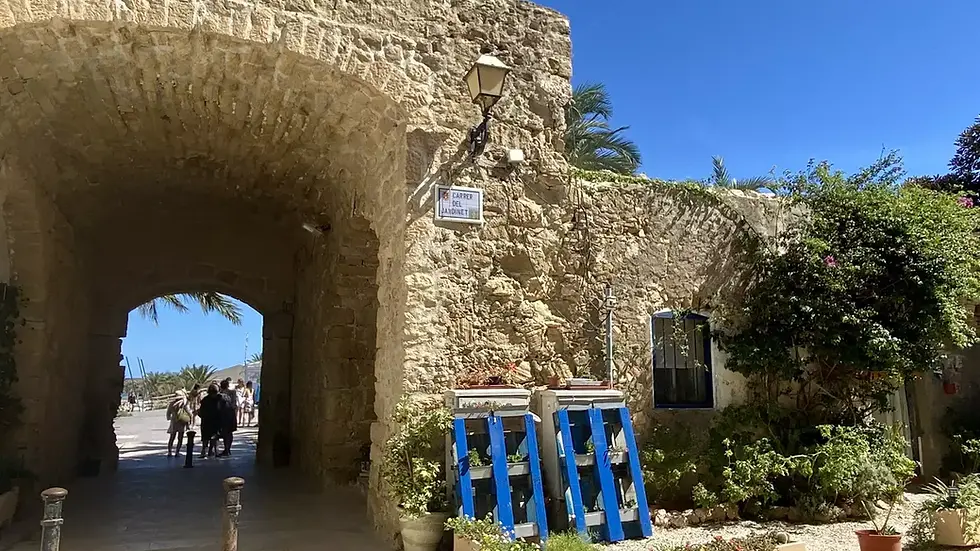Spain's Smallest Island: A Paradise Everyone Should Visit at Least Once in Their Lifetime
- iris de neve
- Jun 29
- 3 min read
Updated: Jul 24

Discover Tabarca Island's Charm
Tabarca Island boasts only two main streets and a population of around 50 residents. This small slice of paradise can be reached by boat from Santa Pola, Alicante, Guardamar, Benidorm, and Torrevieja. The boat ride takes between 20 and 40 minutes. While many visitors choose to take day trips, an increasing number prefer to stay longer. Spending one or two nights allows tourists to explore Tabarca at a relaxed pace and minimizes the impact of mass tourism.
Located just 1.8 kilometers long and 400 meters wide, Tabarca is the smallest inhabited island in Spain, full of unique charm and rich history. Walking through its cobbled streets feels like stepping back in time. The island has received multiple accolades, including being declared a Site of Cultural Interest, a Historic-Artistic Site, a Mediterranean Marine Reserve, and a Special Protection Area for Birds (ZEPA).
Unforgettable Natural Beauty
In 1986, Tabarca Island was declared Spain’s first marine reserve. This initiative led to a ban on trawling, protecting its seabed that had suffered from significant fishing pressures in the past. The island's waters abound with diverse marine life, including octopuses, lobsters, groupers, red mullets, turtles, and vibrant meadows of Posidonia oceanica.
The marine reserve has attracted scuba divers and snorkelers, eager to explore its crystal-clear waters. The island's ecosystem is very rich and well-preserved, making it one of Spain's most important nature reserves. The European Union later designated the area as a Special Protection Area for Birds, enhancing its ecological importance.
It's a breathtaking destination. You might spot colorful fish darting through the water or sea turtles gliding gracefully in the currents. If you're an adventure lover, you'll appreciate the more secluded spots ideal for diving and snorkeling.
Exploring Tabarca's History
Tabarca's history is as rich as its natural beauty. In the 15th and 16th centuries, the island served as a base for Barbary pirates from North Africa. They launched attacks on Christian coasts with the support of the Ottoman Empire. This turbulent history changed in 1769 when Charles III established a colony on the island by bringing in 69 Genoese Ligurian families, who were freed from slavery by paying their ransom. These families formed the basis of what is now known as Nueva Tabarca.
The Attractions of Tabarca Island
Some of the island's main attractions delve deeper into its history and culture.
The Baroque Church of Saints Peter and Paul

Built in the 18th century, this beautiful church features neoclassical elements along with stunning baroque details. Explore its exquisite fleur-de-lis windows and main façade, all showcasing the skills of the craftsmen who worked with the island's stones.
The Governor's House

Currently a hotel, this historic building retains its original archways and floors dating back to 1780. It stands as a testament to the island's storied past.
Llop Marí Cave

This coastal cave is a hidden gem. It features a natural inner beach and strikingly clear waters. Visitors can reach it primarily by kayak or paddleboard for a unique experience.
The Wall and Its Three Doors

The walls of Tabarca feature three historic doors: Puerta de San Rafael, Puerta de San Gabriel, and Puerta de San Miguel. These remnants evoke a sense of the island's ancient Roman spirit.
Local Cuisine and Lodging
Despite its small size, Tabarca offers various lodging and dining options.
Eating on Tabarca Island
Food plays a central role in the Tabarca experience. The island's restaurants provide a wide array of seafood dishes. The famed ‘caldero tabarquino’ is a must-try when dining here. This traditional dish features fish served with potatoes, aioli, and rice broth.
La Almadraba is a popular dining location that specializes in local recipes.

Casa Gloria is another gem on the island. Renowned for its friendly atmosphere and home-cooked meals, it’s the perfect spot for families looking for a personable dining experience.

Lodging Options
Accommodations range from hotels to holiday flats and rural houses.
Hotels: Small hotels like La Trancada provide a cozy vibe.
Holiday Flats: Perfect for families or groups wanting independence during their stay.
Rural Houses: Offer a traditional, intimate experience on the island.
Practical Advice for Staying on Tabarca
Before booking, consider these helpful tips:
Book Early: Accommodations fill quickly in summer.
Check Boat Timetables: Plan arrivals and departures well, as service is limited at night.
Pack Essentials: Tabarca has limited shopping. Bring necessary items like toiletries and sunscreen.
Respect Nature: As a marine reserve, it's crucial to help protect the island’s environment.
Tabarca is not just a destination; it's an experience that combines natural beauty, rich history, and delightful cuisine. It's a place where time stands still, waiting for you to explore.

_edited.png)





Comments